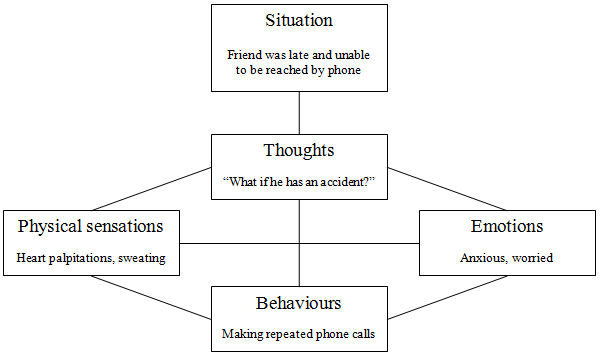| Mental Health Tips | |
| Common Mental Problems | |
| Substance Misuse | |
| Treatment of Mental Disorders | |
| Mental Health Education Pamphlets | |
 Cognitive Behavioural Therapy (CBT)
Cognitive Behavioural Therapy (CBT)
(Special thanks to Ms. Cher Liu (Clinical Psychologist, Castle Peak Hospital) for authoring this article)
When people think of psychotherapy, they usually picture a person lying on a couch, being hypnotized or involved in dream interpretation. Nevertheless, this type of psychotherapy is no longer prevailing, and Cognitive Behavioural Therapy (CBT) has become one of the most well-known and widely-used form of contemporary psychotherapies.
CBT is an evidence-based psychological treatment that aims to change one’s thoughts and behaviours. It is endorsed by National Institute for Health and Clinical Excellence (NICE) and American Psychological Association (APA) to be effective in treating various psychological disorders, including depression, anxiety disorders such as panic disorder, phobia, generalized anxiety disorder, post traumatic stress disorder and obsessive compulsive disorder, as well as helpful for people with bulimia and schizophrenia.
1. What is Cognitive Behavioural Therapy (CBT)?
2. What is likely to happen in CBT?
3. Who offers CBT?
1. What is Cognitive Behavioural Therapy (CBT)?
CBT is based on the idea that our thoughts cause our emotions, behaviours and physical feelings. For instance, while waiting for a friend who was late and unable to be reached by phone, a person who started to think “What if he has an accident?” would feel anxious (emotion), have heart palpitations and sweating (physical sensations) and make repeated phone calls (behaviour). However, thinking that your friend could be trapped in traffic and couldn’t hear the cell phone ringing was unlikely to result in these kinds of reactions. In other words, the same situation can lead to two very different reactions, depending on how you think about it. People are not affected by things, but by the views they take on them.
Figure 1: Relationship between thoughts, emotions, behaviours and physical sensations.
The above figure illustrates how thoughts, feelings, behaviours and physical sensations are inter-related with each other, and change of any parts can break the vicious cycle of negative interactions. CBT aims to help you manage your problems by changing how your think (cognitive) and what you do (behaviour), as well as incorporate problem solving approaches.
2. What is likely to happen in CBT?
In the first session, the therapist will undertake an assessment and help you to develop a shared understanding of your presenting problems. This involves identifying and understanding your problems in terms of relationship between thoughts, feelings and behaviours, and how these affect your daily living. Meanwhile, CBT is a time-limited and relatively short-term psychotherapy which focuses on the present. While it recognizes how events in your past have shaped the way you currently think and behave, it does not dwell on your past and childhood experiences.
The therapist will work together with you to set goals and treatment plan to manage your problems. CBT is a collaborative process, in which it emphasizes not only the therapist’s contribution but also your active participation. The therapist takes an educational role who teaches new skills, and you will be given homework to practice what you have learnt in the sessions, such as keeping a diary to monitor your thoughts or trying out new ways of coping between sessions.
3. Who offers CBT?
CBT is usually provided by clinical psychologists who have related training and experiences in providing this type of intervention, though psychiatrists or other mental health professionals may also be able to offer CBT.
Websites with relevant information / Reference
National Institute for Health and Clinical Excellence, NICEInstitute of Mental Health, Castle Peak Hospital
Beck, J. S. (1995). Cognitive therapy: Basics and beyond. New York: The Guilford Press.
National Institute for Health and Clinical Excellence (2008). Cognitive behavioural therapy for the management of common mental health problems.
Leaflet on the Cognitive Behavioural Therapy (CBT) by the Royal College of Psychiatrists (2010)
梁若芊 (2005) 情緒處理自助手冊: 處理抑鬱情緒。 香港:青山醫院精神健康學院
|
================================================================================ Thank you for browsing the mental health tips on the IMH internet. We would like to hear feedback from you through the questionnaire below. Your comments are most welcome for our continuous improvement. |
No. of visitors of this page: 13373


